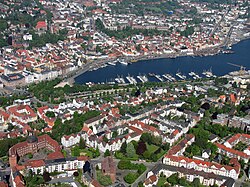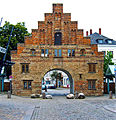Flensburg
Flensburg, Germany | |
|---|---|
 Flensburg Harbour in 2012 | |
| Coordinates: 54°46′55″N 09°26′12″E / 54.78194°N 9.43667°E | |
| Country | Germany |
| State | Schleswig-Holstein |
| District | Urban district |
| Subdivisions | 13 Stadtbezirke |
| Government | |
| • Lord mayor | Simone Lange (SPD) |
| Area | |
| • Total | 56.38 km2 (21.77 sq mi) |
| Elevation | 12 m (39 ft) |
| Population (2020-12-31)[1] | |
| • Total | 89,934 |
| • Density | 1,600/km2 (4,100/sq mi) |
| Time zone | UTC+01:00 (CET) |
| • Summer (DST) | UTC+02:00 (CEST) |
| Postal codes | 24901–24944 |
| Dialling codes | 0461 |
| Vehicle registration | FL |
| Website | www |
Flensburg (Danish and Low Saxon: Flensborg, Frisian: Flensburch, North Frisian: Flansborj) is a city in Germany. It is next to the border with Denmark. About 90,164 people live in Flensburg. The city has a university. A very well known part of Flensburg is Mürwik. There lies a small navy harbour. Flensburg lives on tourism, students and the German navy forces.
History
[change | change source]There was a first settlement about 1200 A.D., which became a city in 1284. In the following century, Flensburg became the economic centre of the Duchy of Schleswig. In 1409 there were battles between people of the Duchy of Holstein and the Danish crown about the control of Schleswig. In 1412 and 1500 there were bad plagues in Flensburg. In 1485, there was a big fire in the city.
Between 1460 and 1864 Flensburg was the second most important harbour in Denmark after Copenhagen. Since the 16th century Flensburg was an important place for trade. Flensburg became part of Prussia in 1864, after the Danish-Prussian War.
In 1920, there was an election in Schleswig. The vote was to decide whether people wanted to belong to Denmark or Germany. Flensburg and regions south of the city decided to stay German, while regions north of the city chose to become Danish.
In 1945, many Germans were driven out of their homes in the eastern German provinces. These people went to Flensburg. The city had more than 100,000 inhabitants for a couple of years. Nowadays Flensburg has about 85,000 inhabitants.
-
Flensburg (2005)
-
Marineschule Mürwik
-
Mürwiker Wasserturm
-
Alexandra
-
KBA in Mürwik
References
[change | change source]Other websites
[change | change source]![]() Media related to Flensburg at Wikimedia Commons
Media related to Flensburg at Wikimedia Commons











